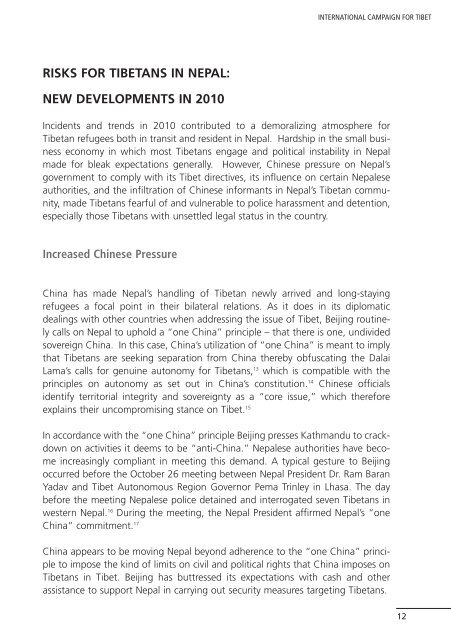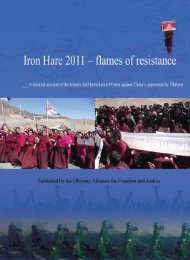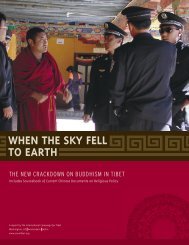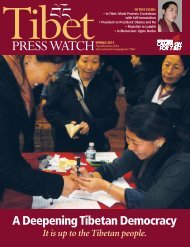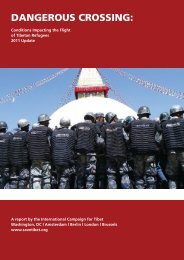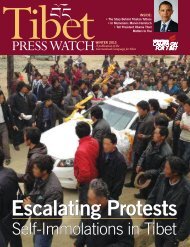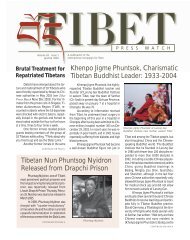DANGEROUS CROSSING: - International Campaign for Tibet
DANGEROUS CROSSING: - International Campaign for Tibet
DANGEROUS CROSSING: - International Campaign for Tibet
Create successful ePaper yourself
Turn your PDF publications into a flip-book with our unique Google optimized e-Paper software.
RISKS FOR TIBETANS IN NEPAL:<br />
NEW DEVELOPMENTS IN 2010<br />
Incidents and trends in 2010 contributed to a demoralizing atmosphere <strong>for</strong><br />
<strong>Tibet</strong>an refugees both in transit and resident in Nepal. Hardship in the small business<br />
economy in which most <strong>Tibet</strong>ans engage and political instability in Nepal<br />
made <strong>for</strong> bleak expectations generally. However, Chinese pressure on Nepal’s<br />
government to comply with its <strong>Tibet</strong> directives, its influence on certain Nepalese<br />
authorities, and the infiltration of Chinese in<strong>for</strong>mants in Nepal’s <strong>Tibet</strong>an community,<br />
made <strong>Tibet</strong>ans fearful of and vulnerable to police harassment and detention,<br />
especially those <strong>Tibet</strong>ans with unsettled legal status in the country.<br />
Increased Chinese Pressure<br />
INTERNATIONAL CAMPAIGN FOR TIBET<br />
China has made Nepal’s handling of <strong>Tibet</strong>an newly arrived and long-staying<br />
refugees a focal point in their bilateral relations. As it does in its diplomatic<br />
dealings with other countries when addressing the issue of <strong>Tibet</strong>, Beijing routinely<br />
calls on Nepal to uphold a “one China” principle – that there is one, undivided<br />
sovereign China. In this case, China’s utilization of “one China” is meant to imply<br />
that <strong>Tibet</strong>ans are seeking separation from China thereby obfuscating the Dalai<br />
Lama’s calls <strong>for</strong> genuine autonomy <strong>for</strong> <strong>Tibet</strong>ans, 13 which is compatible with the<br />
principles on autonomy as set out in China’s constitution. 14 Chinese officials<br />
identify territorial integrity and sovereignty as a “core issue,” which there<strong>for</strong>e<br />
explains their uncompromising stance on <strong>Tibet</strong>. 15<br />
In accordance with the “one China” principle Beijing presses Kathmandu to crackdown<br />
on activities it deems to be “anti-China.” Nepalese authorities have become<br />
increasingly compliant in meeting this demand. A typical gesture to Beijing<br />
occurred be<strong>for</strong>e the October 26 meeting between Nepal President Dr. Ram Baran<br />
Yadav and <strong>Tibet</strong> Autonomous Region Governor Pema Trinley in Lhasa. The day<br />
be<strong>for</strong>e the meeting Nepalese police detained and interrogated seven <strong>Tibet</strong>ans in<br />
western Nepal. 16 During the meeting, the Nepal President affirmed Nepal’s “one<br />
China” commitment. 17<br />
China appears to be moving Nepal beyond adherence to the “one China” principle<br />
to impose the kind of limits on civil and political rights that China imposes on<br />
<strong>Tibet</strong>ans in <strong>Tibet</strong>. Beijing has buttressed its expectations with cash and other<br />
assistance to support Nepal in carrying out security measures targeting <strong>Tibet</strong>ans.<br />
12


